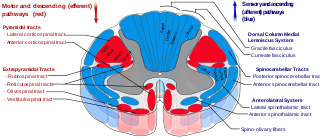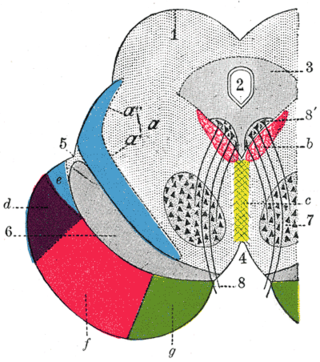
Redlichiida is an order of trilobites, a group of extinct marine arthropods. Species assigned to the order Redlichiida are among the first trilobites to appear in the fossil record, about halfway during the Lower Cambrian. Due to the difficulty to relate sediments in different areas, there remains some discussion, but among the earliest are Fallotaspis, and Lemdadella, both belonging to this order. The first representatives of the orders Corynexochida and Ptychopariida also appear very early on and may prove to be even earlier than any redlichiid species. In terms of anatomical comparison, the earliest redlichiid species are probably ancestral to all other trilobite orders and share many primitive characters. The last redlichiid trilobites died out before the end of the Middle Cambrian.

The parietal lobe is one of the four major lobes of the cerebral cortex in the brain of mammals. The parietal lobe is positioned above the temporal lobe and behind the frontal lobe and central sulcus.

The temporal lobe is one of the four major lobes of the cerebral cortex in the brain of mammals. The temporal lobe is located beneath the lateral fissure on both cerebral hemispheres of the mammalian brain.

The occipital lobe is one of the four major lobes of the cerebral cortex in the brain of mammals. The name derives from its position at the back of the head, from the Latin ob, 'behind', and caput, 'head'.

The midbrain or mesencephalon is the uppermost portion of the brainstem connecting the diencephalon and cerebrum with the pons. It consists of the cerebral peduncles, tegmentum, and tectum.

The cerebrum, telencephalon or endbrain is the largest part of the brain, containing the cerebral cortex as well as several subcortical structures, including the hippocampus, basal ganglia, and olfactory bulb. In the human brain, the cerebrum is the uppermost region of the central nervous system. The cerebrum develops prenatally from the forebrain (prosencephalon). In mammals, the dorsal telencephalon, or pallium, develops into the cerebral cortex, and the ventral telencephalon, or subpallium, becomes the basal ganglia. The cerebrum is also divided into approximately symmetric left and right cerebral hemispheres.
Astereognosis is the inability to identify an object by active touch of the hands without other sensory input, such as visual or sensory information. An individual with astereognosis is unable to identify objects by handling them, despite intact elementary tactile, proprioceptive, and thermal sensation. With the absence of vision, an individual with astereognosis is unable to identify what is placed in their hand based on cues such as texture, size, spatial properties, and temperature. As opposed to agnosia, when the object is observed visually, one should be able to successfully identify the object.

The spinocerebellar tracts are nerve tracts originating in the spinal cord and terminating in the same side (ipsilateral) of the cerebellum. The two main tracts are the dorsal spinocerebellar tract, and the ventral spinocerebellar tract. Both of these tracts are located in the peripheral region of the lateral funiculi. Other tracts are the rostral spinocerebellar tract, and the cuneocerebellar tract.
The two-streams hypothesis is a model of the neural processing of vision as well as hearing. The hypothesis, given its initial characterisation in a paper by David Milner and Melvyn A. Goodale in 1992, argues that humans possess two distinct visual systems. Recently there seems to be evidence of two distinct auditory systems as well. As visual information exits the occipital lobe, and as sound leaves the phonological network, it follows two main pathways, or "streams". The ventral stream leads to the temporal lobe, which is involved with object and visual identification and recognition. The dorsal stream leads to the parietal lobe, which is involved with processing the object's spatial location relative to the viewer and with speech repetition.

Brodmann area 31, also known as dorsal posterior cingulate area 31, is a subdivision of the cytoarchitecturally defined cingulate region of the cerebral cortex. In the human, it occupies portions of the posterior cingulate gyrus and medial aspect of the parietal lobe. Approximate boundaries are the cingulate sulcus dorsally and the parieto-occipital sulcus caudally. It partially surrounds the subparietal sulcus, the ventral continuation of the cingulate sulcus in the parietal lobe. Cytoarchitecturally it is bounded rostrally by the ventral anterior cingulate area 24, ventrally by the ventral posterior cingulate area 23, dorsally by the gigantopyramidal area 4 and preparietal area 5 and caudally by the superior parietal area 7 (H) (Brodmann-1909).

The ventral ramus is the anterior division of a spinal nerve. The ventral rami supply the antero-lateral parts of the trunk and the limbs. They are mainly larger than the dorsal rami.
Pseudohaloritidae is the larger of two families that form the goniatitid superfamily Pseudohaloritoidea, the other being the monogenerc Maximitidae. They are part of the vast array of shelled cephalopods known as ammonoids that are more closely related to squids, belemnites, octopuses, and cuttlefish, than to the superficially similar Nautilus.

Aturia is an extinct genus of Paleocene to Miocene nautilids within Aturiidae, a monotypic family, established by Campman in 1857 for Aturia Bronn, 1838, and is included in the superfamily Nautilaceae in Kümmel 1964.

Corticopontine fibers are projections from layer V of the cerebral cortex to the pontine nuclei of the ventral pons. They represent the first link in a cortico-cerebello-cortical pathway mediating neocerebellar control of the motor cortex. The pathway is especially important for voluntary movements.
Syringonautilidae is a family of Nautiloidea from the middle to late Triassic. Syringonautilidae comprise the last of the Trigonoceratoidea and are the source for the Nautilaceae which continued the Nautiloidea through the Mesozoic and into the Cenozoic right down to the recent. Syringonautilidae is a strictly Triassic family, derived early in the Triassic from the Grypoceratidae.

Grypoceratidae is the longest-lived family of the Trigonoceratoidea, or of the near equivalent Centroceratina; members of the Nautilida from the Upper Paleozoic and Triassic.
The Centroceratidae is the ancestral family of the Trigonoceratoidea and of the equivalent Centroceratina; extinct shelled cephalopods belonging to the order Nautilida
The painted swellshark is a little-known species of catshark, belonging to the family Scyliorhinidae, found in eastern Indonesia. This species reaches a maximum known length of 72 cm (28 in), and has a thick body with a short, broad and flattened head. It is dark gray with a variegated pattern of irregular darker and lighter blotches above, and lighter below with gray blotches and speckling on the snout. Like other swellsharks, it can inflate itself as a defensive measure.
Nannocetus is an extinct baleen whale belonging to the family Cetotheriidae.










